Archaeological Journal Volume 1 Page 142
Archaeological Journal Volume 1 Page 142 is in Archaeological Journal Volume 1.
Observations on the Primeval Antiquities of the Channel Islands (pp 142-151) F. C. Lukis (age 55)
The love for Archaeological knowledge which has been revived of late, and the present endeavours to render the subject more universal and encouraging, induce me to give an outline of those researches which have recently been made in my immediate neighbourhood. To mark with some degree of precision the different periods in the history of man, when the ancient memorials still left for our contemplation were constructed, or, at least, were in the occupation of their original founders, has ever been, and is still, the chief object of the antiquary. The outward evidences which present themselves to the eye of the observer are sometimes few, and, in many instances, vague and unsatisfactory; in such cases, if the spade and the mattock can be resorted to, these powerful auxiliaries will disclose much useful information. The value of these means can scarcely be questioned, but the careful and judicious use of them must be impressed on the mind of the student, who, in his zeal after hidden treasures, may mar or ruin the most interesting points of his practical researches.
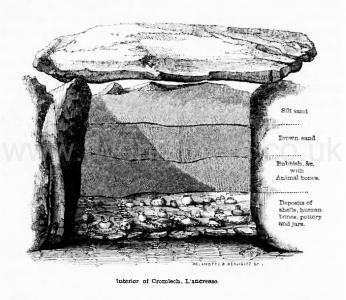
It will not be inconsistent with this outline of my labours, nor will it less accord with the chief and laudable object of the present Journal, to place before the reader the following tables, shewing the position of the substances exposed by these means during the investigation of the remains in question in some parts of these islands.
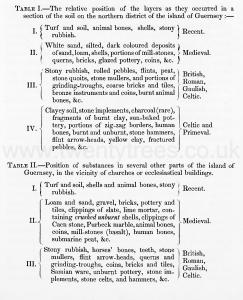
Although the regularity of the strata, as shewn in the foregoing tables, was subject to some variations, from accidental disturbances, yet the general arrangement of the materials was similar over an extensive district; and it may be further stated, that wherever the examinations were pursued, these indications were found to correspond.
The isolated situation commonly occupied by the Cromlech, the Stone Circle, and the Maen-hir, has associated these structures with those localities over which a halo of mystery and awe has ever been spread.
The grave, the church-yard, the dark cavern, and the lonely cairn, still in our day continue to fill the mind of the ignorant with timid fears or apprehensions of evil. The "heaped-up earth" and turf, which once lay over the covering stones of the cromlech, having been long ago removed or levelled by time, these ancient depositories of the dead have become exposed and left in detached portions, standing like giant spectres deprived of those accessories which completed their original form. Neglected throughout many generations, their once venerated site and hallowed use forgotten, their very name lost or doubtfully preserved amid the changes which the soil has undergone, they are left standing in solemn ruin, the gaze of ignorant wonder, the perplexity of the antiquary. Attracted by the magnitude of their dimensions and peculiar forms, our forefathers regarded them as the work of super-human agency. Their various names have thus become associated with fairies, hobgoblins, giants, and dwarfs, in all countries where they exist. The "Cromlech," or "inclined stone" of Britain, the "Grotte aux Pees," "La chambre du Diable" of the French, and the Celtic "Pouquelaye" of these islands, all designate certain localities under elfin influence, and from which the vulgar mind is yet apt to recoil with feelings of superstition and dread. These terms are however significant, for they testify to that ignorance of their original use which followed the extinction of the race which erected them. Those structures which have resisted the effects of time and remain entire, owe their preservation, in many instances, to their remote distance from the haunts of man, or to that superstition which has in after ages paralyzed the hand of wanton destruction.
The names "Druid's Altar," "Temple des Druides," convey a definite meaning when applied to the cromlech, properly so called, and probably owe their origin to the generally received opinion, and the incorrect translation of the word cromlech, or "inclined stone" affirmed by certain writers as disposed to permit the blood of the victims to flow from west to east! all which is mere conjecture and equally untenable. The more approximate derivation of the word, if ever it was originally applied to these structures, would be from the "croum" (Breton), or "cromen" (Welch), signifying a dome or vault,—and "lech," a stone, or "lie," a place or room, (lieu, Fr., locus, Lat.,) or, as in these islands, "pouque," and "laye" or "lee," (from whence puck, an elf, or dwarf,) meaning the place of the fairy.
The "inclined stone" again, on the contrary, is frequently horizontal, exhibiting a position at once bold and hazarded almost beyond the laws of stability; thus it stands a monument invested with wonder, inducing the illiterate to ascribe to it extraordinary uses, and its erection to some invisible power. Names, however common, have some meaning, therefore they should be well considered, and the antiquary knows the value of examining further when these occur. The writer has had on many occasions within the range of his researches nothing but the name to stimulate or encourage him, and seldom has he been disappointed.
It is scarcely necessary to state, that ancient remains which have outlived their generation, and have lost their original purpose, are like the dead over which they preside, the subjects of much speculation and hypothesis. From the want of favourable opportunities to investigate these structures, conjecture has been excited and coupled with traditionary fables so predominant in the country: these opinions are maintained with great obstinacy, and it is still difficult to raise a doubt contrary to the received creed.
These monuments have been subjected to the rapacity of plunderers from the period they fell into other hands, who did not fail to destroy or annihilate every vestige of their contents; and it is to the ponderous masses with which they were formed that so many of them are yet left, after having lost the precious materials they once enclosed.
The primeval antiquities, to use a term which distinguishes the earliest period from that which is more recent, have essential characters assigned to them, and include all those massive structures of whose origin no authentic record has been obtained or discovered. The early antiquarian remains in these islands belong to a period connected with that which has usually been called British, Gaulish, Cymric, and Celtic, and were certainly the works of the primeval race which inhabited them. They have been but imperfectly examined, and with the exception of two or three Druid's altars, described in the Archaeologia, little had been done to investigate them before the present time.
Without entering into the subject of "Druidism," or the habits and customs of the Celtic race, it will suffice to describe the materials and appearances in those monuments which have been explored in these islands.
THE CROMLECHS.—After the investigation of about twenty of these chambers of the dead, and examining their contents, the result has been convincing and satisfactory as to their original use, and they can no longer be considered otherwise than as ancient catacombs, erected by a remote people.
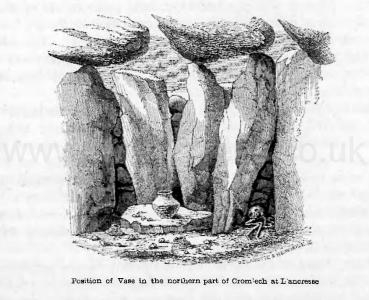
The first cromlech [Les Vardes Burial Mound [Map]] which was inspected is situate on the summit of a gentle hill, standing in the plain of L'ancresse, in the northern part of Guernsey. The spot was well chosen, being remarkable at a distance, and the highest ground in the neighbourhood. Large blocks of granite are here and there visible on the sides, and in their form emulate the quiet resting-place now described. Five large cap-stones are seen rising above the sandy embankment which surrounds the place: these rest on the props beneath, and the whole catacomb is surrounded by a circle of upright stones of different dimensions. The length of the cromlech is 41 feet from west to east, and about 17 feet from north to south, on the exterior of the stones. At the eastern entrance the remains of a smaller chamber is still seen; it consisted of three or four capstones, and was about 7 feet in length, but evidently within the outer circle of stones. At the period it was constructed the sea was at a greater distance from the site of the hill than at present, for the whole neighbourhood bears marks of the inroads of that element: the near approach of the sandy hills around it was caused by those events which have so materially changed the coast of these islands, as well as that of the opposite continent. The period assigned for this devastation is doubtful, but as early as the fifth or sixth century, the Mont St. Michel, in France, once standing in the midst of a wood, was left "in periculo maris" by the incursions of the surrounding ocean. Before these events however happened, the cromlech now spoken of was in existence, and it stood like a faithful guardian of the trust reposed within its sacred limits. The discovery of this monument, and its partial disturbance, took place in the year 1811, by a party of soldiers, who were permitted to dig about it, but after a few days of unprofitable labour, the fears that the massive cap-stones would fall in, induced the then lieutenant-governor to discontinue the work. The sand being allowed to accumulate, the whole was nearly again covered, when in 1837 I commenced the investigation of this ancient monument of the dead.
Tradition has left us no trace of its original name. Its earliest appellation is that of Le Mont St. Michel, given it most probably in the mediaeval period, when the monks of Mont St. Michel established an abbey in the neighbourhood, part of which is still seen, near the Yale church, which is also dedicated to that saint. The "Temple des Druides," "Druid's Altar," and L'autel des Vardes," are all modern names, given it since 1811.
As soon as an entrance could be obtained so as to work the interior, the upper stratum was found to consist of white sand, of the same description as that which is universally spread over the land in the vicinity, called the Common of L'ancresse. The next layer was sand of a dark colour, which appeared to have been silted at an earlier period than the first mentioned.
The same appearances are observed over various parts of the common. Immediately below was found stone-rubbish, and portions of the sides of the cromlech, which had at some distant period fallen in; this was accompanied by animal bones, these were chiefly of the horse, the ox, and boars tusks. After this followed a dark stratum, containing limpet shells, broken pottery, stones worn on two sides by rubbing for grindingprocesses, which were called mullers, portions of stone troughs used for pounding, flat stone quoits, animal bones burnt, and stone hammers. The lowest bed now appeared, in which were found jars and vessels of sun-baked pot tery, human bones, burnt and unburnt, mixed with smooth pebbles of dark blue sienite and greenstone, flint arrowheads, and stone celts.
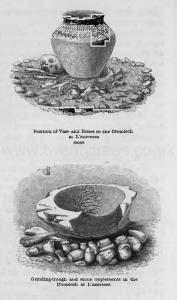
The mass in the centre of the cromlech lay in greater confusion and disturbance than the substances which were found near the sides. On the south side a flat slab of granite was discovered; it was supported upon small blocks, having the appearance of a diminutive cromlech, and as the inside was still unmolested and free, the first complete jar was removed carefully, with stone and bone ornaments and clay beads. It was then observed that this lowest stratum lay upon a flat pavement of rude flags of granite, and that the jars and bones were placed in distinct heaps on the floor of the cromlech, and that the rolled pebbles mentioned above had been used to separate them in detached spots. The vessels contained only the dark mass which had fallen in, mixed with limpet shells, but in no instance could be perceived the least vestige of human remains within them. The yellow clay, or original soil, was mixed with the contents, without any sand, exhibiting at once its previous state before the inundations of that substance, as stated above. No vestige of any metal was observed during the examination, and the many rude stone implements found therein made it evident that none was then in use; many pieces of clay of a peculiar form were found, from three to six inches in length; these were made by rolling a piece of clay in the hand, and striking each end against a board; they still bear the marks of the inside of the fingers, with the joints and impression of the skin of the maker. The quantity of human bones found within this chamber was great, and corresponded with the number of vessels of all sizes discovered with them. In the spaces between the props were lodged vases, bones, and skulls, as in a recess, after the manner of a catacomb. No attempt at orientation could be here adopted, and the bones were, from their position, brought to their final resting-place after the flesh had been removed by burning, or some other means. The burnt human bones appeared in distinct heaps, and the jars in contact had partaken of the colour of them. The very perfect calcination which had been adopted made it difficult to conceive what kind of process had been used; little or no charcoal was observed; the teeth were of a fine jet black, and the bones of the jaws grayish white, and in some instances tinged with turquoise green colour.
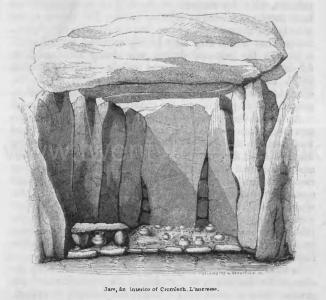
It will be easy to perceive that the various heaps of human remains, which lay scattered on the floor of the cromlech, had been therein deposited at different times. The shapes of the urns in like manner, denoted an improvement in their manufacture, but it was only after having explored several cromlechs that the primeval deposit was clearly ascertained, as consisting of materials of different periods. In some districts which might be imagined of contemporaneous origin, the character of the pottery was found to be very similar, both in respect to their pattern and the quality of the substance used.
As several vessels bore the marks of use previous to interment, there can be no doubt but that the most valuable and useful articles were deemed the most worthy of accompanying the remains of the departed. The same practice still prevails among different tribes in the Southern ocean, as well as among the Esquimaux. The original contents of the vessels could not be ascertained, and excepting limpet shells, no trace of other substances was observed. The fragments of the jars were carefully collected, and being easily distinguished by the thickness or colour of the pottery, they were rejoined together by means of strong glue or cement, and restored to their former shape.
In most instances the mode of fracture was indicated by the edge of the fragments, and confirmed the supposition of the gradual filling of those vessels which had retained an upright position in the cromlech. When the primeval deposit consisted of two or more layers, the difference was easily perceived by the yellow clay which prevailed in the lowest bed, and in which the more ancient materials were always discovered. The next stratum was of a dark colour, and contained a greater number of limpet shells and vessels, differing in shape and material.
The lower stratum, which contained the original or more ancient materials, must have lain undisturbed for many years before the next layer covered it. A singular proof of this was exhibited in exploring a cromlech in the island of Herm, where a human skull, found in the lower stratum, was curiously covered with snails' shells, which had hibernated upon its surface. The death of these snails (Helix Nemoralis) must have occurred after the falling in of the sides, or second deposit, when being covered over they remained fixed to the spot. This circumstance, with the appearances of the cromlech at L'ancresse, and the observations made at the Creux des Fees, in the parish of St. Saviour's, prove the original state of the dark sepulchral chamber.
About forty urns of different sizes were obtained from the cromlech at L'ancresse, but from the quantity of pottery found therein, not fewer than one hundred varieties of vessels must have been deposited from time to time during the primeval period. The figures of the urns will form the subject of another paper. The largest was about eighteen inches in height, the smallest four.
The markings and zig-zag borders appeared to have been made by the hand with some sharp instrument, during the period of the hardening of the clay in the sun's rays. The clay beads were of various sizes. Some measured two inches in diameter; others were flat, with the perforation countersunk. No coin or metal of any sort was discovered, although the greater part of the contents was passed through a sieve, the use of which cannot be too strongly recommended in such researches.
The grinding-troughs were doubtless in use at a very early period, and appear to have been succeeded by the querns, which existed in private families till the introduction of mills. The process of pounding could be well performed by means of the stone mullers here shewn. They were simple rolled pebbles of various sizes, and were used as a pestle, or worked round the trough with the hand. This method is still observed among the natives of India and South America, where rice and other grain is to be pounded. Some of these are worn on one side, others on both sides, until they became wedge-shaped, whilst some are flat at both extremities.
F. C. LUKIS
Llewellynn Jewitt 1870. In the Channel Islands the indefatigable and laudable researches of Mr. Lukis (age 81) show that the galleried stone chambers of the tumuli in that district had been used by successive generations for many ages. One of the most important of these is the gigantic chambered burial place, surrounded by a stone circle, at L'Ancresse [Map], in Guernsey. In this, "five large capstones are seen rising above the sandy embankment which surrounds the place; these rest on the props beneath, and the whole catacomb is surrounded by a circle of upright stones of different dimensions. The length of the cromlech is 41 feet from west to east, and about 17 feet from north to south, on the exterior of the stones. At the eastern entrance the remains of a smaller chamber is still seen; it consisted of three or four capstones, and was about seven feet in length, but evidently within the outer circle of stones"1. In a careful examination made by Mr. Lukis (age 81), many highly interesting features were brought to light, of which he has given an excellent account in the "Archaeological Journal,"2 to which the reader cannot do better than refer. The engravings there given, show the interiors of some of the chambers, with their deposits in situ, and exhibit some of the highly interesting relics found during the excavations. The pottery was of a totally distinct character from that of the Celtic period found in England, some of the forms being of what are usally considered the Anglo-Saxon type, and are the result of the use of these chambers by successive generations, as already named.
Note 1. F. C. Lukis.
Note 2. Vol. I. p. 142.